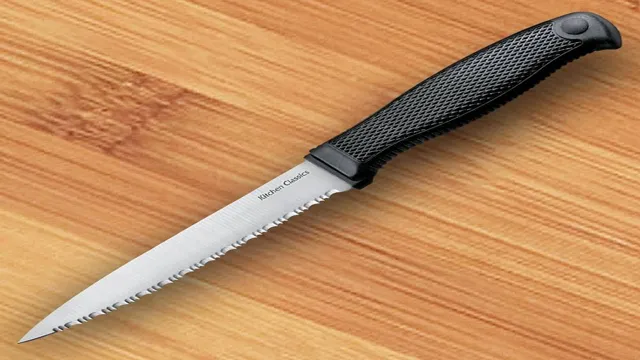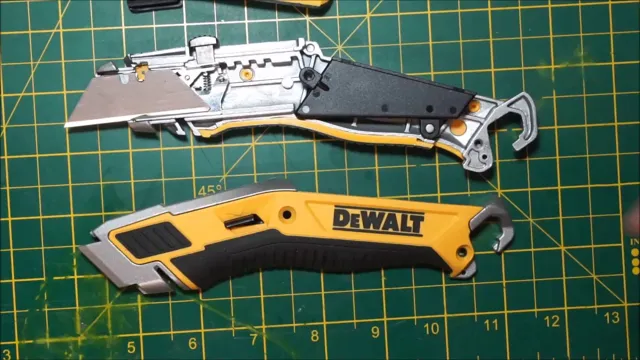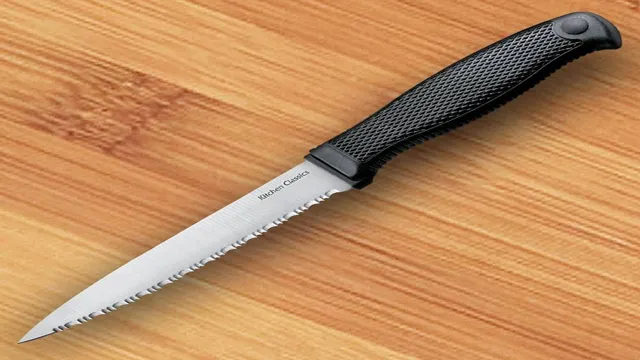Can You Cut Hardboard with a Utility Knife? Here are the Tips to Make it Work!

Cutting hardboard can be a challenge, especially if you don’t have the right tools. But sometimes, a utility knife is all you have on hand, and it can actually be a useful tool for cutting hardboard. Hardboard is a dense, tough material that requires some force to cut, but with a little patience and the right technique, it can be done.
In this blog post, we’ll show you how to cut hardboard with a utility knife, step-by-step. So, whether you’re a DIY enthusiast or a professional carpenter, keep reading to learn some new tips and tricks for working with hardboard.
Understanding Hardboard
If you’re wondering whether you can cut hardboard with a utility knife, the answer is yes! Hardboard is a strong and durable material made from wood fibers that have been compressed and glued together. While it may seem like it would be tough to cut, a sharp utility knife can do the job just fine. However, it’s important to take safety precautions when working with hardboard, as it can produce fine dust particles that can be harmful to breathe in.
Make sure to wear a dust mask and protective eyewear before cutting. Additionally, you may need to make multiple passes with the utility knife to achieve a clean cut, as hardboard can sometimes be prone to splintering. Overall, with the right tools and safety measures in place, cutting hardboard with a utility knife is a simple and straightforward process.
What is hardboard?
Hardboard is a versatile and durable engineered wood material that has become popular due to its affordability and usage in various woodworking projects. It is made by compressing wood fibers and resin under high pressure and temperature, creating a dense, smooth surface that is resistant to warping, bending, and shrinking. Hardboard possesses a smooth, consistent surface that resembles plywood and can be easily painted, cut, and drilled, making it ideal for use in cabinetry, furniture, and decorative paneling.
Its lightweight and strength make it suitable for subflooring, wall linings, and ceiling paneling. If you are looking for a versatile and affordable engineered wood material for your next DIY project, consider using hardboard.

Types of Hardboard
Hardboard is a versatile and durable material that can be used in a variety of applications. There are several types of hardboard available on the market, each with its own unique characteristics and uses. Standard hardboard is made from compressed wood fibers and is commonly used for interior applications such as wall paneling, underlayment, and furniture backing.
Tempered hardboard is treated with oil and resin, making it more resistant to moisture and heat. It is often used for exterior applications, as well as in the manufacture of furniture and cabinetry. Perforated hardboard is designed with pre-drilled holes, making it ideal for use in storage and organization systems.
Other types of hardboard include paintable hardboard, which is designed to be painted without the need for primer, and whiteboard hardboard, which is coated with a white, dry-erase surface for use as a whiteboard. Overall, hardboard is a cost-effective, easily accessible material that can be used in a wide range of applications.
How is it used?
Understanding hardboard can be challenging, but it is an important material to know if you’re working on construction, furniture, or arts and crafts projects. Hardboard, also known as high-density fiberboard (HDF), is made by compressing wood fibers under high levels of heat and pressure. This creates a strong and durable material that can be cut, drilled, and shaped to fit specific needs.
It is often used as a substitute for plywood, particleboard, and even solid wood in certain applications. One of the advantages of hardboard is its smooth surface, which makes it ideal for painting and printing. It is also affordable compared to other materials and has low VOC emissions.
Hardboard comes in different grades and thicknesses, so it’s essential to determine the right one for your project. Whether you’re building shelves, creating art panels, or constructing a stage platform, hardboard is a versatile material that provides excellent results with proper usage.
Using a Utility Knife to Cut Hardboard
If you’re wondering whether you can cut hardboard with a utility knife, the answer is a resounding yes! A utility knife is perfect for cutting hardboard, thanks to its sharp, flexible blade. By using a steady hand and applying firm, even pressure along a straight edge, you can effectively cut through hardboard with a utility knife. Just be sure to use caution and wear protective gloves, as the hardboard can be rough and splinter easily.
Additionally, it’s essential to keep your utility knife blade sharp, as a dull edge can make cutting harder and potentially lead to mistakes. So, if you’re looking for a convenient and inexpensive way to cut hardboard, consider using a utility knife. It might just be the right tool for the job!
Choosing the Right Knife
When it comes to cutting hardboard, a utility knife is an excellent choice. A utility knife typically features a sturdy, sharp blade that can cut through tough materials with ease. To use a utility knife on hardboard, start by marking your cut line with a straight edge.
Next, score the surface of the hardboard with the utility knife, applying firm pressure as you go. Once you’ve scored the surface, go back over the line a few more times until you’ve cut through the hardboard completely. It’s important to note that a dull knife can make this task much more difficult and dangerous.
Be sure to choose a utility knife with a sharp blade and replace it as needed to ensure the best results.
Preparing Your Work Surface
Preparing your work surface is essential before starting any DIY project, and using a utility knife to cut hardboard is no exception. First, ensure that your work surface is clean and free of debris to avoid any obstructions while cutting. Before beginning, make sure your utility knife has a sharp blade, as a dull blade can make the cutting process more difficult.
Start by measuring the hardboard to the desired length and mark it with a pencil. Apply pressure to the knife while making your cut, and make multiple passes if needed. Remember to hold the hardboard steady with your non-dominant hand and wear gloves for safety.
By taking these steps, you can ensure a smooth and accurate cut on your hardboard for your next project.
Measuring and Marking the Hardboard
Measuring and marking hardboard accurately is crucial to ensure a successful DIY project. One tool that can be used for this is a utility knife. Before starting, make sure to measure the hardboard and mark the area to be cut.
Use a straight edge to draw a line, and then score the surface of the hardboard several times with a utility knife. Apply firm pressure while doing this to ensure a clean and smooth cut. Once scored, bend the hardboard along the cut line and snap it apart.
Repeat the same process on the other side of the hardboard. Using a utility knife is an effective way to cut hardboard, but always be cautious and make sure to wear protective gear to avoid any accidental injuries.
Cutting the Hardboard
Cutting hardboard can seem like a daunting task, but using a utility knife can make it much easier. Start by marking the area you want to cut with a straight edge or ruler, creating a clear line to follow. Using a sharp utility knife, score the hardboard along the marked line, making multiple passes if necessary to ensure a deep enough cut.
Once the score line is deep enough, you can then snap the board along the cut, creating a clean break. It’s important to use a sharp blade to ensure a clean cut and to take your time, as rushing can lead to mistakes. With a little patience and practice, cutting hardboard with a utility knife can become a simple and efficient task.
Tips and Tricks for Cutting Hardboard
Hardboard is a robust, versatile material that is perfect for a variety of DIY projects. Whether you’re building bookshelves, cabinets, desks, or workbenches, it’s essential to know how to cut hardboard to the right size and shape. When it comes to cutting hardboard, you may be wondering if you can use a utility knife.
Well, the answer is yes, you can use a utility knife to cut hardboard. However, keep in mind that hardboard is a dense material, which means it can be difficult to cut cleanly. Therefore, it’s best to use a sharp blade, preferably one designed for use with hardboard.
A dull blade will not only make your job more challenging but may also damage the board’s surface. Additionally, it’s essential to use a straightedge or a guide to ensure your cuts are straight and neat. With these tips and tricks, you’ll have no trouble cutting hardboard to the exact size and shape you need for your DIY projects.
Using a Straight Edge
One of the best practices when cutting hardboard is to use a straight edge. This tool is essential because it provides a stable and straight guideline for your blade, ensuring you make straight and accurate cuts. When using a straight edge, make sure to secure it firmly and press it down as you cut to prevent it from shifting or slipping.
Additionally, always use a sharp blade and take your time to avoid damaging your material or injuring yourself. With practice, using a straight edge can become a quick and effortless process that will make your hardboard cutting projects much easier and more efficient. So, next time you plan to work on a project that involves hardboard, don’t forget to add a straight edge to your toolkit!
Making Multiple Cuts
Cutting hardboard can be an intimidating task, especially if you need to make multiple cuts. However, there are tips and tricks that can make the process a lot smoother. First off, make sure you have the right tools for the job.
A circular saw with a fine-toothed blade is ideal for cutting hardboard. It’s also important to measure your cuts carefully and mark them clearly. If you need to make several cuts of the same size, try clamping a straight edge to the hardboard to use as a guide.
This will help ensure that your cuts are straight and even. Another useful tip is to make shallow cuts first, gradually increasing the depth until you have cut all the way through the hardboard. This will help prevent splintering and chipping.
With these tips in mind, you should be able to make multiple cuts on hardboard with ease and precision.
Safety Precautions
When it comes to working with hardboard, there are a few safety precautions that you should always keep in mind. First and foremost, make sure that you are wearing the proper protective equipment. This should include safety goggles, a dust mask, and gloves.
Additionally, you should always make sure that your work area is well-ventilated so that you don’t inhale any harmful fumes or dust. When cutting hardboard, you should use a sharp blade and be very careful not to let the saw blade kick back. Remember to keep your hands away from the saw blade, and always use a push stick to guide the material through the saw.
By following these simple tips and tricks, you can safely and effectively cut hardboard with ease, without putting yourself or others in harm’s way.
Conclusion
So, can you cut hardboard with a utility knife? In theory, yes. But in practice, it might be a frustrating and time-consuming task. So unless you enjoy the experience of feeling like a squirrel chewing on a tree branch, you might want to invest in a proper saw or a utility knife with a more robust blade.
Remember, the right tool makes all the difference in the outcome of any project!”
FAQs
What is hardboard?
Hardboard is a type of engineered wood made from compressed wood fibers.
What can hardboard be used for?
Hardboard is commonly used for paneling, furniture, flooring, and as a backing material for cabinets and bookcases.
Can hardboard be cut with a utility knife?
Yes, hardboard can be cut with a utility knife, but it may require multiple passes or sharpening the blade more frequently.
What other tools can be used to cut hardboard?
Other tools that can be used to cut hardboard include a jigsaw, circular saw, or handsaw.
Is hardboard waterproof?
No, hardboard is not waterproof, but it can be made more water-resistant by adding a sealant or coating.
What is the thickness of hardboard?
Hardboard is typically available in thicknesses ranging from 1/8 inch to 1/4 inch.
What is the price range of hardboard?
The price of hardboard can vary depending on the thickness and size, but it is generally an affordable option compared to other types of wood products.







